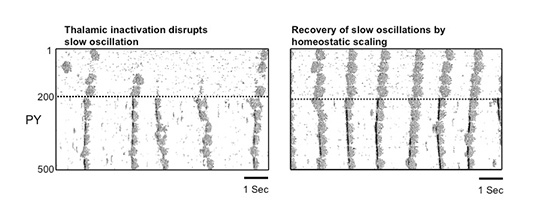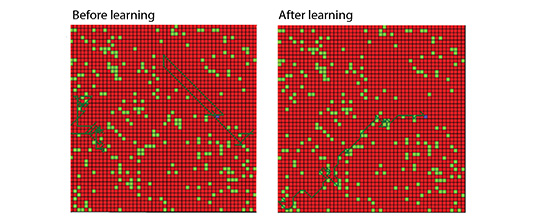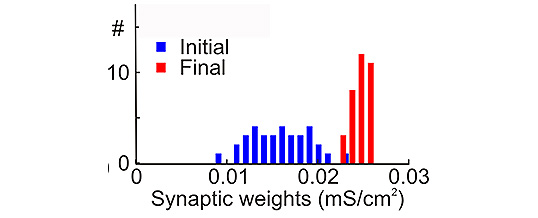JUL
During natural slow-wave sleep (SWS), brain activity recorded from electroencephalogram (EEG) is characterized by large-amplitude fluctuations of field potential, which reflect synchronous alternating periods of activity (cortical Up states) and silence (cortical Down states) across the thalamocortical system. Recovery of slow oscillations after extensive thalamic lesions and the absence of slow oscillations in the thalamus of decorticated cats pointed to an intracortical origin for this rhythm. If was suggested that thalamic neurons play a merely secondary role simply ...
Read More →APR
Plasticity is a universal property of synapses. It is expressed in a variety of forms mediated by a multitude of mechanisms. Here we consider two broad kinds of plasticity that differ in their requirement for presynaptic activity during the induction. Homosynaptic plasticity occurs at synapses that were active during the induction. It is also called input specific or associative, and it is governed by Hebbian-type learning rules. Heterosynaptic plasticity can be induced by episodes of strong postsynaptic activity also at ...
Read More →APR
The National Science Foundation’s Graduate Research Fellowship Program GRFP recognizes and supports outstanding graduate students in NSF-supported science, technology, engineering, and mathematics disciplines who are pursuing research-based master’s and doctoral degrees at accredited US institutions. Oscar Gonzales was awarded by this prestigious fellowship for his research on the topic of epileptogenesis and seizures.
Breaking in precise balance of excitation and inhibition in brain networks may promote hyper-synchronization and lead to epileptic seizures. Multiple factors potentially affecting this delicate balance include ...
Read More →MAR
Rewarded spike timing dependent plasticity (STDP) has been implicated as a possible learning mechanism in a variety of brain systems. This mechanism combines unsupervised STDP that modifies synaptic strength depending on the relative timing of presynaptic input and postsynaptic spikes together with a reinforcement signal that modulates synaptic changes. In this study, rewarded STDP was implemented as part of a spiking network model of excitatory cells and inhibitory interneurons. The network was used to model basic foraging behavior ...
Read More →MAR
Sleep facilitates the consolidation of memories. The number of sleep spindles (transient neural events in non rapid eye movement (NREM) sleep, 9–15 Hz) in a post-training sleep period correlates with the magnitude of declarative memory improvement (e.g., conscious, episodic memories), whereas minutes in REM sleep correlate with improvement in non-declarative memories (e.g., unconscious, perceptual or sensorimotor skills).
Although the studies report that individual sleep features correlate with improvement in specific memory domains, we do not know if manipulating these sleep features ...
Read More →JAN
Spike timing dependent plasticity (STDP) modifies synaptic strength depending on the relative timing of pre-synaptic input and post-synaptic spikes. The effects of STDP in computational models often lead to physiologically inaccurate or unstable distributions of synaptic strength. Examples of stable but physiologically unrealistic synaptic strength distributions include bimodal distributions and highly skewed distributions. Connection strengths also tend to be excessively unstable for learning. Preventing this “run-away” dynamics using basic STDP mechanisms requires fine tuning of learning rules and ...
Read More →OCT
Octopamine (OA) underlies reinforcement during appetitive conditioning in the honey bee and fruit fly, acting via different subtypes of receptors. Recently, antibodies raised against a peptide sequence of one honey bee OA receptor, AmOA1, were used to study the distribution of these receptors in the honey bee brain (Sinakevitch et al., 2011). These antibodies also recognize an isoform of the AmOA1 ortholog in the fruit fly (OAMB, mushroom body OA receptor). Here we describe in detail the distribution of AmOA1 ...
Read More →OCT
In this paper, we introduce and study systematically, in terms of phase response curves, the effect of dual-pulse excitation on the dynamics of an autonomous oscillator. Specifically, we test the deviations from linear summation of phase advances resulting from two small perturbations. We analytically derive a correction term, which generally appears for oscillators whose intrinsic dimensionality is >1. The nonlinear correction term is found to be proportional to the square of the perturbation. We demonstrate this effect in the Stuart-Landau ...
Read More →OCT
Trauma and brain infection are the primary sources of acquired epilepsy, which can occur at any age and may account for a high incidence of epilepsy in developing countries. We have explored the hypothesis that penetrating cortical wounds cause deafferentation of the neocortex, which triggers homeostatic plasticity and lead to epileptogenesis (Houweling etal., 2005). In partial deafferentation experiments of adult cats, acute seizures occurred in most preparations and chronic seizures occurred weeks to months after the operation in ...
Read More →SEP





